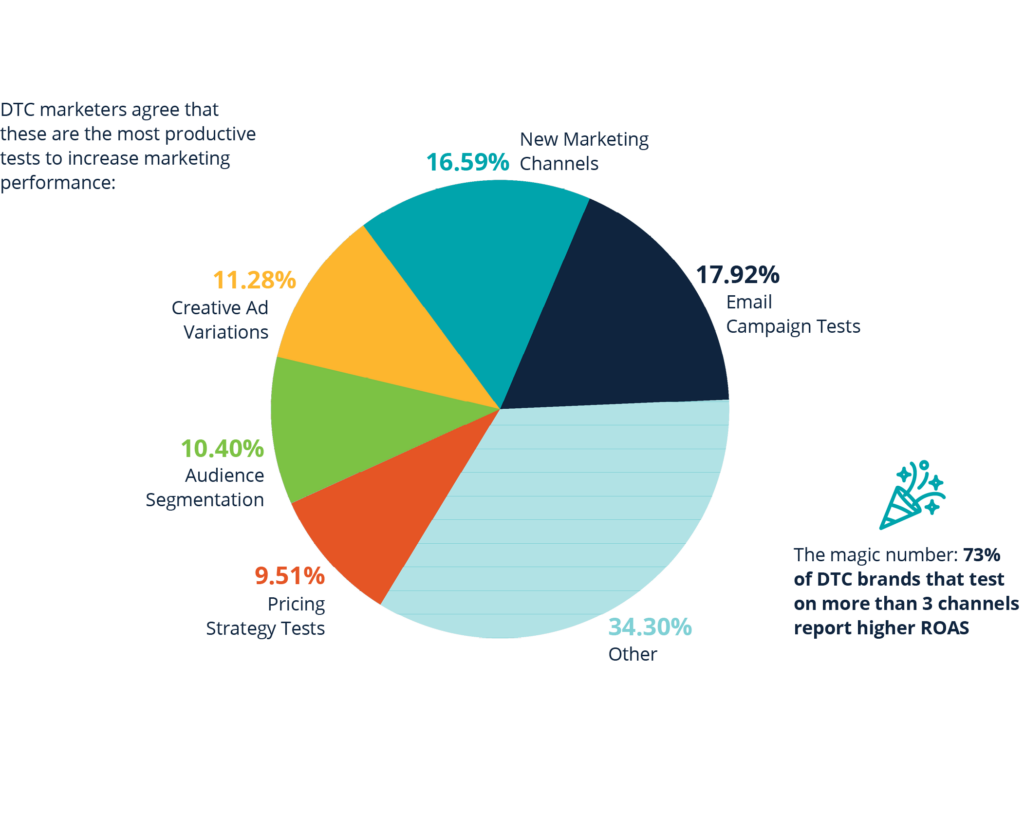The world of direct-to-consumer (DTC) marketing is crowded and chaotic. With the intensity of competition increasing daily, channel diversification is no longer an option—it’s a necessity.
Marketers need to meet ambitious return on ad spend (ROAS) and cost per acquisition (CPA) goals, and relying on just one or two channels can limit any brand’s reach and growth potential. In this blog, we’ll dive into why channel diversification is critical, how today’s DTC brands handle it, and actionable strategies to diversify channels for maximum impact.
This blog highlights data from Nift’s latest eBook, Navigating Success: Insights from Marketers on Channel Diversification. The in-depth report features real-world, actionable data from a survey of over 150 retail marketing executives. With these insights, DTC and retail brands can leverage data to blow their CPA, ROAS, and net new acquisition goals out of the water. Download your free copy of the eBook here.
Key takeaways from this blog:
- No access to first-party data is a top obstacle for 83% of DTC marketing teams.
- 89% of marketers want to escape walled gardens like Amazon and Meta by using first-party data, but only 40% are sure they have enough first-party data.
- 73% of DTC brands that test on more than 3 channels report higher ROAS
Let’s dive in!
Why Channel Diversification is Critical to Reaching ROAS and CPA Goals
Marketing channel diversification is a strategy that uses a variety of channels to market and promote your brand, products, or services and achieve your marketing goals. For example, instead of relying on just Meta ads to achieve your ROAS and CPA goals, channel diversification uses multiple channels like Meta, social media, email marketing, affiliate marketing, referral and gift marketing, and more to reach new customers.
Achieving ROAS and CPA targets is becoming increasingly challenging as competition grows, advertising costs rise, and consumer behaviors shift. Diversification offers a solution by allowing brands to tap into new, often underutilized, marketing avenues. By spreading efforts across multiple channels, brands reduce their dependence on any single platform, lowering the risk of rising costs or diminishing returns in a particular area.
Moreover, channel diversification allows marketers to meet customers where they are. Whether email, social media, search, or emerging platforms like TikTok or podcasts, a well-rounded marketing strategy ensures that brands connect with their audience at every touchpoint. As these channels perform differently for different segments, they can offer a broader view of customer behavior, ultimately leading to more optimized spend, stronger ROAS, and better CPA performance.
The State of Channel Diversification in Today’s DTC Market
In 2024, the DTC landscape is vastly different from what it was even a few years ago, forcing many DTC brands to evolve their marketing approaches.
Brands that relied heavily on Facebook and Google are now testing newer channels like Pinterest ads, Amazon PPC, or TikTok influencers to reach untapped audiences. Many DTC marketers have expanded beyond digital channels, incorporating strategies such as direct mail into their marketing mix. This omnichannel approach is being embraced to strengthen brand presence while allowing for better optimization and more reliable scaling.
However, despite these efforts, many DTC marketers need full help to diversify their marketing mix. Some of the most notable challenges to this complex strategy include:
- Skyrocketing customer acquisition costs (CAC)
- Decreasing conversion rates
- Difficulty in testing channels against each other
- Not utilizing ‘owned’ channels like email or blogs
- Consistent branding across multiple channels
Moreover, a lack of experience with new platforms and insufficient tracking and attribution can create barriers to success, which is why an intentional, data-driven approach is key.
3 Strategies for Effective Marketing Channel Diversification
Marketers must adopt a structured approach to channel diversification to get the most out of their marketing spend and ensure long-term growth and success. Here are the three most effective channel diversification strategies from Nift’s 2024 Marketing Channel Diversification Report:
1. Test Channels Against Each Other
The key to successful channel diversification is robust testing. Without testing, there’s no way to know whether a channel is doing its job!
Brands must evaluate how channels perform for their audience by conducting A/B tests on messaging, formats, and targeting strategies. For example, a brand might test Facebook ads against Google search or Amazon Sponsored Products against TikTok influencer collaborations. The goal is to identify which channels provide the best results based on specific KPIs: ROAS, CPA, or customer acquisition.
DTC marketers agree that these are the most productive tests to increase marketing performance:

Regularly assessing performance also ensures brands can shift spending to the highest-performing platforms while scaling back on those that underperform, all without losing sight of long-term goals.
2. Optimize Each Channel
Once you identify the right mix of channels, it’s time to double down on optimization. Each platform has nuances and learning curves, so investing the time and effort to master these differences can pay off big time.
For instance, optimizing Google Ads may involve fine-tuning keyword strategies or perfecting landing page relevance, while Pinterest ads require a focus on creative visuals and audience segmentation. Similarly, TikTok ads thrive on authenticity and storytelling, while referrals and gifts require hyper-personalization. Diversification is essential, but optimization ensures you get the most value from each channel.
3. Leverage First-Party Data
First-party data helps marketers create hyper-personalized campaigns that resonate with their target audience, resulting in better engagement and conversions. It also helps improve cross-channel attribution, allocating spending and optimizing channels more efficiently.
Marketers have built their acquisition and retention strategies around first-party data and cookies for years. However, recent changes have restricted businesses from tracking and accessing the data they need—including customer names, emails, and mobile numbers—to reach their target audience. This is hurting the bottom line of DTC marketers.
No access to first-party data is a top obstacle for 83% of DTC marketing teams.
First-party data is undoubtedly one of the most powerful tools in a marketer’s arsenal today. As data privacy regulations tighten and third-party cookies phase out, brands need to leverage their own data to drive their marketing efforts. 89% of marketers want to escape walled gardens like Amazon and Meta by using first-party data, but only 40% are sure they have enough.
There is a solution to privacy woes: Alternative marketing channels that collect first-party data, including emails and mobile numbers, legally and without the high price tag. DTC marketers don’t rely on channels like Amazon, Meta, and Google to capture and utilize customer data. With channels like Nift, DTC brands can use first-party data to discover who purchases their products or services.
Why Marketers Need to Consider Alternative Growth Channels
Relying solely on traditional digital channels can be limiting in an era of ad fatigue and rising customer acquisition costs. Alternative growth channels—such as influencer marketing or referrals and gifts like Nift—offer a chance to diversify away from oversaturated platforms and tap into fresh audiences.
These channels often come with lower costs and provide opportunities to engage consumers in new, innovative ways, such as through native content, influencer partnerships, or personalized gift offers. Alternative channels are often less competitive, making achieving higher ROAS and lower CPAs easier than on significant platforms like Meta or Google.
By expanding into these areas, brands can also build a more comprehensive marketing mix that adapts to evolving consumer preferences, reducing the risk of relying on just one or two platforms for growth.
A New Era Of DTC Marketing Is Here
Channel diversification is essential for DTC marketers looking to reach ambitious ROAS and CPA goals in 2024 and beyond. Brands can create a resilient, scalable marketing strategy by testing different channels, optimizing performance, and leveraging first-party data through alternative marketing channels.
But that’s not all! Download our eBook to learn more about the intricacies of marketing channel diversification, including:
- How to navigate a cookie-less world
- 6 emerging alternative marketing channels (and if they’re the right fit for your brand)
- 3 critical KPIs DTC marketers need to measure
- How to manage and hit your CPA targets
- And more!
Snag your free copy here. Better yet, if you’re ready to start with Nift Advertising for DTC Brands, request a demo with our team.
About the Author
Cynthia LaRue is the Vice President of Marketing at Nift, where she develops an integrated sales and marketing growth strategy to elevate the Nift brand, foster customer awareness, and drive brand preference across various marketing channels.
Cynthia’s passion lies in leveraging digital platforms to connect with customers innovatively, driving demand for Nift. Collaborating closely with the Sales Team, she spearheads efforts to transform capabilities and stay ahead in the ever-evolving e-commerce industry. Her commitment to fostering diverse and engaged teams is at the core of her approach.
Throughout her career, Cynthia has navigated both scrappy startups and global enterprises. Before joining Nift, she served as the Head of Marketing for ShipStation. Her impressive track record includes pivotal roles at Fortune 500 organizations such as The Home Depot and Mars, where she focused on digital e-commerce and held P&L responsibilities for the M&M’s brand.
Outside of work, Cynthia resides in the greater Houston, TX, area with her husband. She indulges her creativity by designing jewelry, exploring hiking trails, kayaking, swimming, and writing. Cynthia holds a dual degree in management and an MBA from Belhaven University, where she graduated Summa Cum Laude.


